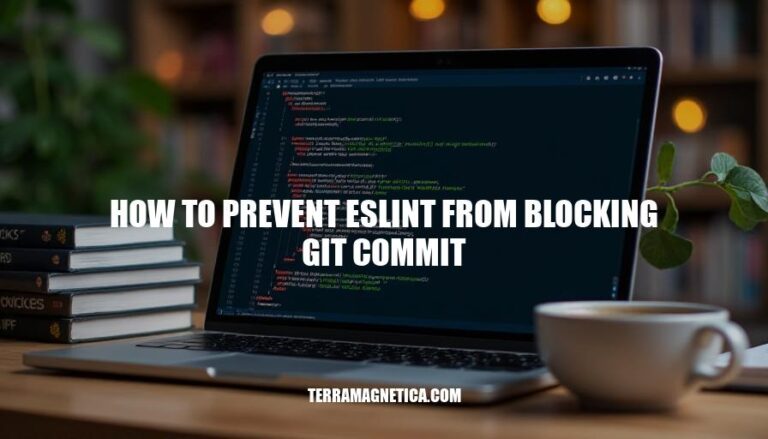


Understanding how to prevent ESLint from blocking Git commits is crucial for maintaining a smooth development workflow. This issue typically arises when pre-commit hooks are configured to run ESLint checks, ensuring code quality before changes are committed. While this helps maintain clean and consistent code, it can also block commits if linting errors are present. Addressing this is essential for developers to avoid workflow disruptions and ensure that minor linting issues don’t hinder progress. Properly managing these hooks allows for a balance between code quality and efficient development.
ESLint is a static code analysis tool for JavaScript. It identifies problematic patterns in your code, such as potential errors and coding style violations, helping maintain consistent and high-quality code.
Git Commit Process:
git add <file> to stage changes.git commit -m "message" to commit the staged changes. This creates a snapshot of your repository at that point.ESLint Interference:
Here are common scenarios where ESLint might block a git commit:
Code Style Violations:
function example() {
console.log('Hello, world!');
}
const longString = "This is a very long string that exceeds the maximum line length set in the ESLint configuration.";
Syntax Errors:
const name = 'John'
if (true) {
console.log('Hello, world!');
Linting Issues:
const unusedVar = 42;
console.log(undeclaredVar);
These issues are typically caught by ESLint during the commit process, ensuring code quality and consistency.
Sure, here are the step-by-step instructions to configure ESLint to prevent it from blocking git commits, including specific settings and commands to bypass or disable ESLint checks during commits:
Install Dependencies:
npm install eslint husky lint-staged --save-dev
Configure ESLint:
Create a .eslintrc.json file in the root of your project with your desired ESLint configuration.
Set Up Husky and Lint-Staged:
Add the following configuration to your package.json:
{
"husky": {
"hooks": {
"pre-commit": "lint-staged"
}
},
"lint-staged": {
"*.js": [
"eslint --fix",
"git add"
]
}
}
Bypass ESLint Checks During Commits:
Use the --no-verify flag with your git commit command to bypass the pre-commit hook:
git commit -m "Your commit message" --no-verify
These steps will set up ESLint with Husky and lint-staged to run checks on your code before commits, and the --no-verify flag will allow you to bypass these checks when necessary.
To use Git hooks for managing ESLint checks, follow these steps:
Install Dependencies:
npm install eslint husky lint-staged --save-dev
Configure ESLint:
Create an .eslintrc.json file:
{
"extends": "eslint:recommended",
"env": {
"browser": true,
"node": true,
"es6": true
},
"rules": {
"semi": ["error", "always"],
"quotes": ["error", "single"]
}
}
Set Up Husky:
Add Husky to your package.json:
{
"husky": {
"hooks": {
"pre-commit": "lint-staged"
}
}
}
Configure lint-staged:
Add lint-staged to your package.json:
{
"lint-staged": {
"*.js": [
"eslint --fix",
"git add"
]
}
}
Skip ESLint Check:
If you need to bypass the ESLint check for a specific commit, use:
git commit -m "your message" --no-verify
This setup ensures that ESLint runs on staged files before each commit, automatically fixing issues where possible, and only blocking commits if there are errors that can’t be fixed automatically.
Here are some best practices to prevent ESLint from blocking your Git commits while maintaining code quality:
Use Husky and lint-staged:
npm install husky lint-staged --save-dev."husky": {
"hooks": {
"pre-commit": "lint-staged"
}
},
"lint-staged": {
"*.js": ["eslint --fix", "git add"]
}
Run lint checks locally:
npx eslint ..Use ESLint warnings:
"rules": {
"new-rule": "warn"
}
Set a maximum number of warnings:
--max-warnings flag to prevent new violations from being introduced:eslint . --max-warnings 10
Automate formatting with Prettier:
"lint-staged": {
"*.js": ["prettier --write", "eslint --fix", "git add"]
}
By following these practices, you can maintain code quality without compromising the commit process.
it’s essential to configure Husky and lint-staged properly.
This involves installing Husky and lint-staged as dev dependencies, configuring Husky to run lint-staged on pre-commit, and setting up lint-staged to only lint staged files with ESLint and Prettier.
Additionally, running ESLint locally regularly, using ESLint warnings instead of errors initially, setting a maximum number of warnings, and automating formatting with Prettier are crucial best practices to maintain code quality without compromising the commit process.
By following these steps and tips, developers can ensure a smooth development workflow while keeping their codebase clean and error-free.